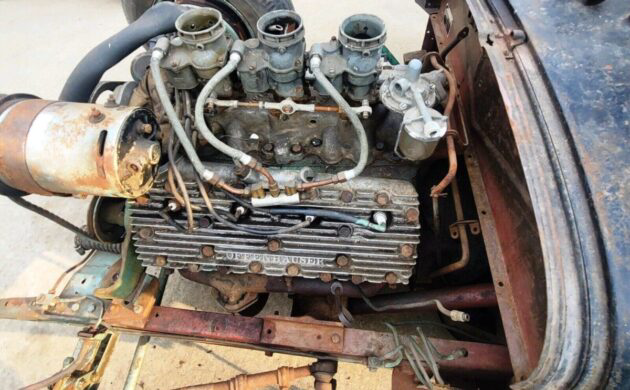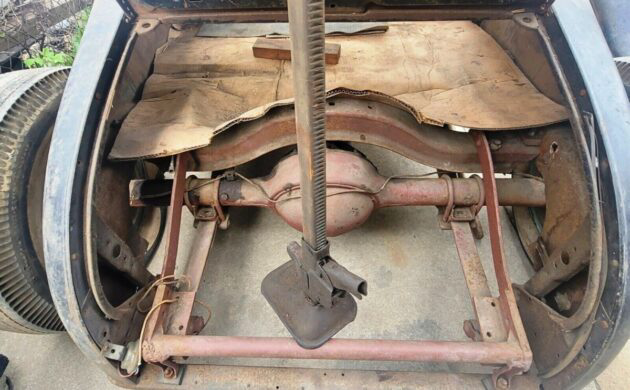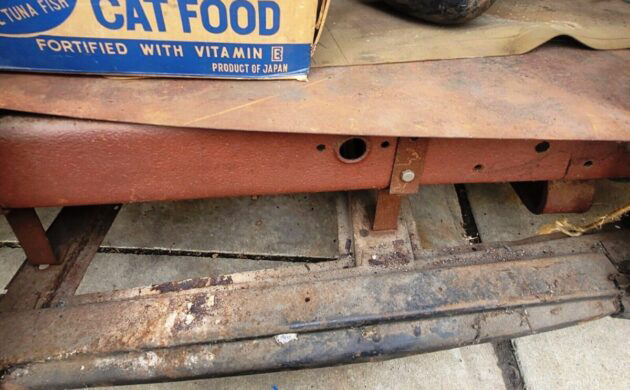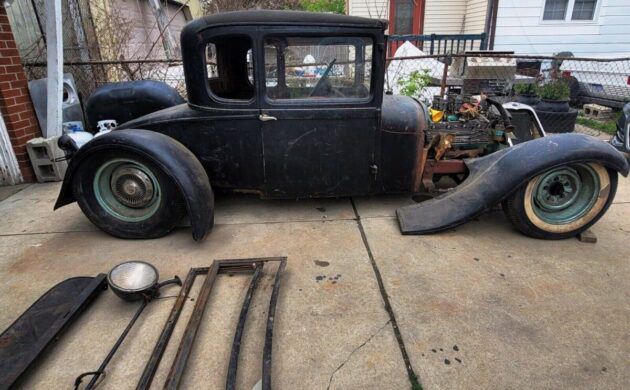Parked in the ’60s, this roughly channeled steel-top coupe captures a snapshot in time of that era’s grass-roots hot-rodding. Sporting a later flathead V8 and a crude channel job, this custom hit the streets with the roadway echoing and visible below. The 1929 Ford Model A Coupe in Croswell, Michigan appears to have kept a stock-height roof, a unique look from a time when most rods had their tops chopped or became topless roadsters. Listed for $7500 here on eBay, this classic will need a ton of work, though a sympathetic refurbishment, merely finishing the original vision, will benefit the new owner’s wallet and street credibility. Thanks to reader T.J. for spotting this long-stored “A.”
The 24-stud “flathead” Ford V8 dates to no earlier than 1938, according to VanPeltSales, and produced at least 85 HP stock. The Offenhauser heads and triple carburetors topped that number for sure, making this lightweight A-bone significantly faster than stock. Flaunting the triples and “Offy” heads adds significant gravity, a force known to attract gear-heads and the occasional heavenly body.
Ford fans might identify the early automatic transmission, an interesting surprise on this vintage rod, though plenty of races were won with two-speed automatics given the right gears and tuning. Metal strapping the headlight bucket to the cross-bar suggests this bucket hit the road before being fully baked. Knowing the ’60s, the driver may have been partially baked as well.
Despite the hefty 1/4″ or 3/16″ steel, those DIY frame rails should be replaced with boxed steel members. What looks like a venerable Ford 9″ rear axle didn’t come out until 1957, one of few elements we might call over-engineered.
Normally a channel job involves making fully weather-proof modifications to the body so the frame passes through it. In this case the floor structure appears to have been completely cut out and re-assembled beneath the frame with no rubber mounts or provision for inevitable flex. As cool as this ride looks, I’d separate the parts and completely re-engineer it while maintaining a similar slammed stance.
Fenders resting atop the tires and other extra parts likely hail from the pre-build state, and will need work to fit the channeled custom. What modifications do you like or notice on this ’60s custom Ford?








Certainly agree with you Todd. Totally disregarding the asking price all I see here is a bunch of parts.
The Fordomatic was first available in 1950 and the rear axle at that time looks a lot like a 9 inch.
If and when it ever does run, at least there’s little chance of roll-over.
It’s a Low Rider
I like the channeled not chopped look. Would be a good project for Iron Trap Garage, they like to rescue old hot rods and finish them the way the builder seemed to be going
My wife and I today toured Edsel and Elenore house and wow the selling of these beauties sure built a wonderful estate
@Todd Fitch
This particular car has the “East Coast” look. That was common back then for them to channel and/or section their cars but not chop the tops. And the “West Coast” look did include chopped tops.
I have two friends who have Model A coupes that were done in this area of North Carolina by the same man. One friend has had his car since 1974 and the other since 1966! They are channeled and sectioned with untouched tops.
BTW, the one that has been owned since 1966 is now red and has a Chevrolet Big Block engine with a tunnel ram and 2×4 carbs. When he bought it, it was Silver Blue and had a Thunderbird 312 mill. I asked him one time how much a person had to pay for a car like that then. He smiled and said, “Eight-hundred dollars.”
It never ceases to amaze me how some mix match of rusted parts gets great reviews, of an example of early Hot Rods from the 50’s and 60’s. First off I would venture a guess, that this car never moved under its own power. It is basically just a bunch of junk rusted parts tacked to gather ,in an effort to look like a car. It is basic yard art and not that good. The Flathead is such a mess of parts they don’t even go together. Distributor 1949 to 1953, Water Pumps 59 ABA, Heads late model, Automatic Transmission from ??. Moving on to suspension the Perch Pins are welled to the Wish Bone Bracket, how would that work? Of course there is no steering, drive shaft or some kind of brake system that could ever stop the car.
This is just incredibly stupid. My best guess is , in the mid sixties there were some teen age boys who had minimal skills , a few tools and wanted a Hot Rod, like their big brother or uncle. They found some car parts and welded and bolted them together, thinking they would work.
What’s funny is now people look at it and think it is a real masterpiece from the fifties Hot Rod Culture. Question, “How many old time Hot Rodder’s does it take to screw in a light bulb”. Don’t know….you weren’t there.
8 ba or Mercury flathead from 1949-52-3 , rear frame steel is factory . Nice bunch of good old hi po parts .
Real rodders had balls of steel and I’d bet it did run and drive at one time and I think this car was a late 40s to late 50s built originally. A friend of my dad had his high school senior year car until he died a few years ago. It was a full fendered 29 coupe he built in the mid-late fifties, chopped 4″, sectioned 4″ and channeled 6″. By 1980 it was Jaguar suspended with a sbc replacing the Caddy flathead he ran back then. The car was one that just looked right all around, beautiful paint, interior and mechanicals (chrome everything under the car except the frame, and under the hood), a real work of art imo, but from pictures he had I liked the looks of it it it’s fifties set up best.
The “hefty” rear frame rails are actually original rear bumper support brackets — would you trust your entire rear suspension to a bumper bracket — this thing will require a total rebuild to be driveable